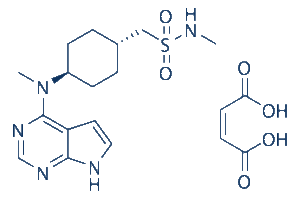Oclacitinib maleate (PF-03394197)
This product is for research use only, not for human use. We do not sell to patients.

For small sizes, please check our retail website as below: www.invivochem.com
| Size | Price | Stock |
|---|---|---|
| 100mg | $400 | In Stock |
| 250mg | $700 | In Stock |
| 500mg | $1050 | In Stock |
Cat #: V2550 CAS #: 1640292-55-2 Purity ≥ 98%
Description: Oclacitinib maleate (formerly PF-03394197 maleate) is a novel and potent inhibitor of JAK (Janus kinase) family members with IC50 values ranging from 10 to 99 nM and JAK1-dependent cytokines with IC50 ranging from 36 to 249 nM.
Top Publications Citing Invivochem Products
Publications Citing InvivoChem Products
Product Promise

- Physicochemical and Storage Information
- Protocol
- Related Biological Data
- Stock Solution Preparation
- Quality Control Documentation
| Molecular Weight (MW) | 453.51 |
|---|---|
| Molecular Formula | C15H23N5O2S.C4H4O4 |
| CAS No. | 1640292-55-2 |
| Storage | -20℃ for 3 years in powder formr |
| -80℃ for 2 years in solvent | |
| Solubility In Vitro | DMSO: 90 mg/mL (198.5 mM)r |
| Water: 18 mg/mL (39.7 mM)r | |
| Ethanol: 90 mg/mL (198.5 mM) | |
| SMILES Code | O=S(C[C@H]1CC[C@H](N(C)C2=C3C(NC=C3)=NC=N2)CC1)(NC)=O.O=C(O)/C=CC(O)=O |
| Synonyms | PF 03394197 maleate; Apoquel; PF-03394197 maleate; PF03394197 maleate; |
| Protocol | In Vitro | Using isolated enzyme systems and in vitro human or canine cell models, potency and selectivity of Oclacitinib is determined against JAK family members and cytokines that trigger JAK activation in cells. Inhibitory activity of Oclacitinib against JAK family members is determined in isolated enzyme systems. Oclacitinib inhibits JAK1, JAK2, JAK3, and TYK2 by 50% at concentrations (IC50's) of 10, 18, 99, and 84 nM, respectively. Oclacitinib is most potent against the JAK1 enzyme, showing a 1.8-fold selectivity for JAK1 vs. JAK2 and 9.9-fold selectivity toward JAK1 vs. JAK3. Oclacitinib inhibits JAK family members by 50% at concentrations (IC50's) ranging from 10 to 99 nM and does not inhibit a panel of 38 non-JAK kinases (IC50's >1000 nM). Oclacitinib also inhibits the function of JAK1-dependent cytokines involved in allergy and inflammation (IL-2, IL-4, IL-6, and IL-13) as well as pruritus (IL-31) at IC50's ranging from 36 to 249 nM. Oclacitinib has minimal effects on cytokines that does not activate the JAK1 enzyme in cells (erythropoietin, granulocyte/macrophage colony-stimulating factor, IL-12, IL-23; IC50's >1000 nM). |
|---|---|---|
| In Vivo | Scratching bouts at the high dose in the Oclacitinib group are significantly less than in the vehicle-only group (P<0.01). |
These protocols are for reference only. InvivoChem does not
independently validate these methods.
| Solvent volume to be added | Mass (the weight of a compound) | |||
|---|---|---|---|---|
| Mother liquor concentration | 1mg | 5mg | 10mg | 20mg |
| 1mM | 2.2050 mL | 11.0251 mL | 22.0502 mL | 44.1005 mL |
| 5mM | 0.4410 mL | 2.2050 mL | 4.4100 mL | 8.8201 mL |
| 10mM | 0.2205 mL | 1.1025 mL | 2.2050 mL | 4.4100 mL |
| 20mM | 0.1103 mL | 0.5513 mL | 1.1025 mL | 2.2050 mL |
The molarity calculator equation
Mass(g) = Concentration(mol/L) × Volume(L) × Molecular Weight(g/mol)
Mass
=
Concentration
×
Volume
×
Molecular Weight*
The dilution calculator equation
Concentration(start)
×
Volume(start)
=
Concentration(final)
×
Volume(final)
This equation is commonly abbreviated as: C1 V1 = C2 V2
Concentration(start)
C1
×
Volume(start)
V1
=
Concentration(final)
C2
×
Volume(final)
V2
Step One: Enter information below
Dosage mg/kg
Average weight of animals g
Dosing volume per animal µL
Number of animals
Step Two: Enter the in vivo formulation
%DMSO
+
%
+
%Tween 80
+
%ddH2O
Calculation Results:
Working concentration:
mg/ml;
Method for preparing DMSO master liquid:
mg
drug pre-dissolved in
µL
DMSO(Master liquid concentration
mg/mL)
,Please contact us first if the concentration exceeds the DMSO solubility of the batch of drug.
Method for preparing in vivo formulation:
Take
µL
DMSO master liquid, next add
µL
PEG300, mix and clarify, next add
µL
Tween 80,mix and clarify, next add
µL
ddH2O,mix and clarify.
Note:
- (1) Please be sure that the solution is clear before the addition of next solvent. Dissolution methods like vortex, ultrasound or warming and heat may be used to aid dissolving.
- (2) Be sure to add the solvent(s) in order.




































